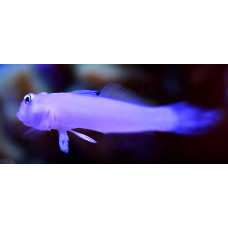Latin name
Valenciennea sexguttata
Other name
Сhalk goby, sleeper blue dot goby.
Identification
These fish have an elongated body covered with smooth scales; pointed face with large eyes.
Features of fish fins
Dorsal spines (total): 7; Dorsal soft rays (total): 12; Anal spines: 1; Anal soft rays: 11-13.
Fish colouring
The body coloration of the Sixspot Goby is light brown with a spotted pattern. Six dark spots are evenly distributed along the body, three on each side.
Distribution
Widespread in the Indian Ocean and western Pacific. In the Red Sea, Persian Gulf and East Africa to Samoa, north to the Yaeyama Islands, Ryukyu, and south to Queensland, Australia.
Habitat
Marine tropical species. Inhabits bays or lagoons at depths of 3 to 25 meters (9.8 to 82.0 feet) on muddy or sandy bottoms with larger pieces of rock under which to hide.
Size
This species can reach a length of 14 centimeters (5.5 inches).
Behavior
They usually live in pairs in burrows under rocks. They are found in large schools in atoll lagoons.
Food and feeding habits
A carnivorous species. Feeds mainly on worms and shrimp.
Reproduction
Monogamous mating is considered obligatory and social.
Fishing
This species is commercially important in fisheries.
Relationship with a person
The Sixspot Goby can be found in the aquarium store.
| Classification | |
| Phylum | Chordata |
| Class | Actinopterygii |
| Squad | Gobiiformes |
| Family | Gobiidae |
| Genus | Valenciennea |
| Species | V. sexguttata |
| Features | |
| Conservation status | Least Concern |
| Habitat | Pelagic |
| Life span, years | No information |
| Maximum body weight, kg | No information |
| Maximum length, cm | 14 |
| Sailing speed, m/s | No information |
| Threat to people | Not edible |
| Way of eating | Predator |
Sixspot goby
Tags: sixspot goby



